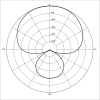A microphone's directionality or polar pattern indicates how sensitive it is to sounds arriving at different angles about its central axis. The polar patterns illustrated above represent the locus of points that produce the same signal level output in the microphone if a given sound pressure level (SPL) is generated from that point.

Omnidirectional:An omnidirectional microphone's response is generally considered to be a perfect sphere in three dimensions. In the real world, this is not the case. As with directional microphones, the polar pattern for an "omnidirectional" microphone is a function of frequency
Cardioid(1, Hypercardioid(2, Supercardioid(3, Subcardioid(4
 |
| Cardioid |
The most common unidirectional microphone is a cardioid microphone, so named because the sensitivity pattern is "heart-shaped", i.e. a cardioid. The cardioid family of microphones are commonly used as vocal or speech microphones, since they are good at rejecting sounds from other directions. In three dimensions, the cardioid is shaped like an apple centred around the microphone which is the "stem" of the apple.
 |
| Hypercardioid |
The cardioid response reduces pickup from the side
and rear, helping to avoid feedback from the monitors.
Since these directional transducer microphones achieve
their patterns by sensing pressure gradient,
putting them very close to the sound source
 |
| Supercardioid |
(at distances of a few centimeters) results in a bass
boost due to the increased gradient.
This is known as the proximity effect. The SM58 has been the
most commonly used microphone for
live vocals for more than 50 years demonstrating
 |
| Subcardioid |
the importance and popularity of cardioid mics.
No comments:
Post a Comment